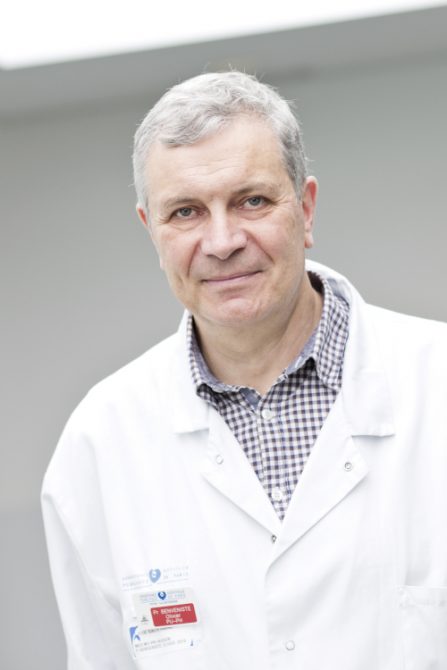
Interview with Prof. Olivier Benveniste, Director of research Team 8, “Inflammatory myopathies and innovative targeted therapies“, at the Institute’s Centre for Myology Research, University Professor – Hospital Practitioner at the Department of Internal Medicine and Clinical Immunology (the DMIIC) at the Pitié-Salpêtrière Hospital, Coordinator for the French National Myositis Network.
If you could provide some background, who you are, what your missions are and where you work?
I am Professor of Internal Medicine and Clinical Immunology at the Department of Internal Medicine and Clinical Immunology (the DMIIC) at the Pitié-Salpêtrière Hospital, which comprises around 100 beds. I head the 3ID (Immunology, Inflammation, Infectiology and Dermatology) Teaching Hospital Department of the Sorbonne University Teaching Hospital Group, which encompasses the Tenon, St Antoine and Pitié-Salpêtrière hospitals. This teaching hospital department is at the frontline in the East of Paris for the care of patients infected with COVID-19. Over 700 healthcare professionals work at this teaching hospital department.
At Pitié-Salpêtrière, the DMIIC plays a key role for patients released from the hospital group’s emergency departments, and is also dedicated to treating patients within the scope of clinical immunology; in particular, systemic diseases, auto-immune diseases and auto-inflammatory diseases, both acute and chronic. The DMIIC encompasses two activities for which its expertise is recognised nationally and internationally: systemic vasculitis (Prof. Cacoub) and inflammatory myopathies or myositis (Prof. Benveniste).
At research Team 8, “Inflammatory myopathies and innovative targeted therapies“, which I head at the Institute of Myology, we are working on translational medicine studies targeted at muscle immunology. I am lucky enough to be able to control all stages of the translational medicine process, including immediate identification of patients identified in consultation or hospitalisation, fine characterisation of their phenotype, entry of this information into the database, sampling in a biobank, fundamental research based on this biobank, definition of the best endpoints for clinical trials, pathophysiological studies “from bench to bedside”, and the development of academic and/or commercial clinical trials, for example the Rapami trial testing the rapamycin (siromilus) drug molecule versus placebo in cases of inclusion body myositis.
How is your time being spent in this current crisis situation?
Since the beginning of the current health crisis, I have been mobilised, with my teams, on several fronts and we have had to continuously reorganise and rethink the way we work.
I am part of the Pitié-Salpêtrière Hospital crisis unit, which meets every day at 11 a.m. to manage all the COVID-19 emergency cases. We are a group of 15 people, representing each hospital specialty, and we perform a daily review of the situation at the hospital, in order to ensure the best organisation of patient flow, visits, reception of detainees, medical care, resuscitation, shifts, etc.
In terms of INSERM research, with my team of 12 people at the Institute of Myology Research Centre, we are continuing our work on inflammatory myopathies. We have launched an appeal for volunteers to help the clinical research teams and account for each patient that we include in the COVID-19 research. For each patient included in the trial, we must record a Clinical Report Form (CRF). The appeal for volunteers has also allowed certain members of the team who have been confined to be of use and to contribute their skills.
We are also working with other units on a “CORIMMUNO” trial involving more than 2000 patients, with a common methodology, and we are testing anti-inflammatory approaches, antivirals and other targeted therapies on COVID-19 patients.
How are you and your team experiencing this situation?
The situation is serious and unprecedented. At the very beginning of the epidemic, we could not help but have a feeling of fear of exposure to the virus, of having to perform resuscitation procedures in the operating room. Then, came a feeling of “excitement”, we were in the middle of the “action” and had to use all our combined skills to face the challenge and save our patients in a real show of solidarity.
It is rare to have such a “carte blanche” in terms of resources and, in this state of crisis where we had to act and react quickly, it was possible to implement therapeutic trials very quickly.
A major difficulty is to maintain this over time and to push the limits, since one is living in a permanent state of fear, of losing patients, of having to make difficult ethical decisions, and anxiety about a shortage of beds.
Why are research and clinical trials important in this context?
In my research group, we have been working for several years on inclusion body myositis (inflammatory myopathies). Three years ago, we conducted a pilot study at INSERM, financed by the AFM, over a one-year period of around 40 elderly patients to test the effects of rapamycin (an immunosuppressant) and to measure over time the change in the condition of the treated patients versus a similar population taking a placebo. The results were more than encouraging.
While awaiting the validation of this trial and its publication, we have taken the decision to treat and follow-up more than 200 patients with this drug molecule, which could certainly prove to be of interest in treating COVID-19.
Therefore, an observational protocol has been put in place for patients with neuromuscular diseases being treated with rapamycin, which will help us to verify later whether this drug molecule has a beneficial, protective effect on these patients in the face of the COVID-19 epidemic.
